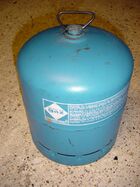Camping Gaz
Camping Gaz is a brand of compressed butane[1] gas designed for use as a fuel whilst camping and caravanning. The fuel gas is compressed to a liquid and sold in characteristically blue metal containers. It was first introduced in the mid 1950s.
The brand name is also used on appliances manufactured for use with the gas: cookers, lanterns, heaters, grills, refrigerators, etc.
Sizes and availability
The small Gaz cartridges are constructed of thin metal and typically used in small cooking rings and gas lamps. Inserting the Camping Gaz cartridge into the device pierces it and allows the fuel gas to flow. The canisters are held in place by a bayonet base, and are discarded when empty. They must be completely empty before they are removed from the appliance, otherwise gas will still escape which is a fire hazard.
Larger Gaz cylinders contain between 0.4 and 2.75 kg of butane,[2] and are fitted with a screw thread onto which a flexible hose can be connected. The hose includes a tap and pressure gauge. These are typically used for applicances like multi-ring cookers, gas refrigerators, grills or heaters. When empty, the cylinders are reused by returning the empty container to a retail outlet where it is exchanged for a new one for the price of the fuel gas.
Camping Gaz bottles are sold all over Western Europe except Scandinavia.
Travelling with cartridges or cylinders
- By air - compressed gas cartridges may not be taken on commercial flights
- By road - Gaz containers can safely be transported by car, but it is advisable to avoid leaving them in direct sunlight. However, the manufacturer states that since they do not explode below 87°C, they would actually be safe in a car parked in sunshine, since cars do not get any hotter than 60°C.[2]
- By tunnel - Eurotunnel permits the transportation of Camping Gaz through the channel tunnel,[3] although they do not permit vehicles fuelled by LPG.
References
- ↑ Neill & Dilys King (2005). "Bottled Gas or LPG". http://www.motorcaravanning.co.uk/vehicles/bottled_gas.htm. Retrieved 2006-08-01.
- ↑ 2.0 2.1 Coleman EMEA (2001). "CAMPINGAZ". http://www.campingaz.com/. Retrieved 2006-08-03.
- ↑ Neill & Dilys King (2005). "European Info - assorted!". Motorhoming in Europe. http://www.motorcaravanning.co.uk/travel/european_info.htm. Retrieved 2006-08-07.
See also
- Calor Gas - a similar product from a competitor


